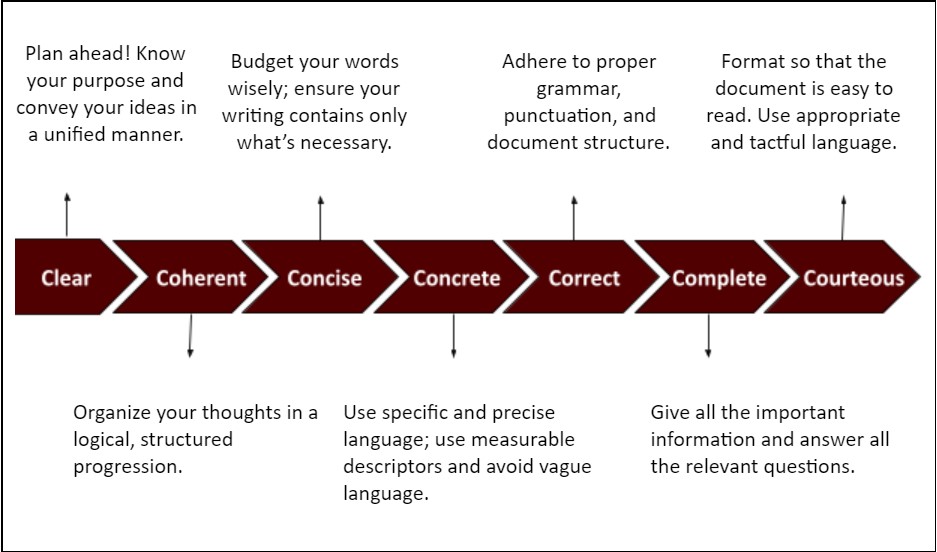5 – Writing Skills
Communicating Professionally
Suzan Last and Nicole Hagstrom-Schmidt
Good professional and technical communication is precise and concise. This precision and concision must be evident at all levels, from the overall document, to paragraphing, to sentence structure, to word choice, and even to punctuation. Every word or phrase should have a distinct and useful purpose. If something doesn’t, remove or revise the content.
In this chapter, you will learn how to write and revise precisely and concisely. You will also be introduced to English sentence structures and how you may use them in your technical and professional communication. Finally, this chapter concludes with specific guidelines on punctuation, including rules for commas, end punctuation, and other less common punctuation marks such as colons, semicolons, and em dashes.
The 7 Cs of Professional Writing
The 7 Cs are simply seven words that begin with C that characterize strong, professional style. Applying the 7 Cs of professional communication will result in writing that is
- Clear
- Coherent
- Concise
- Concrete
- Correct
- Complete
- Courteous.
Clear writing involves knowing what you want to say before you say it, because often a lack of clarity comes from unclear thinking or poor planning. Clear writing immediately conveys the purpose of the document to the reader; it matches vocabulary to the audience, avoiding jargon and unnecessary technical or obscure language, while at the same time being precise. In clarifying your ideas, ensure that each sentence conveys one idea and that each paragraph thoroughly develops one unified concept or topic.
Coherent writing means that the reader can easily follow your ideas and your train of thought. One idea should lead logically into the next through the use of transitional words and phrases, structural markers, planned repetition, sentences with clear subjects, clear headings, and parallel lists. Writing that lacks coherence often sounds “choppy,” and ideas seem disconnected or incomplete. Coherently connecting ideas is like building bridges between islands of thought so that the reader can easily move from one idea to the next.
Concise writing uses the fewest words possible to convey the greatest meaning while still maintaining clarity. William Zinsser asserts that “the secret of good writing is to strip every sentence to its cleanest components.”[1] Avoid unnecessary padding, awkward phrasing, overuse of “to be” forms (is, are, was, were, am, be, being), long preposition strings, vagueness, and unnecessary repetition. Use active verbs whenever possible, and choose a single word rather than a long phrase or clichéd expression. Think of your word count like a budget; be cost effective by making sure every word you choose does effective work for you.
Concrete writing involves using specific, precise language to paint a picture for your readers so that they can more easily understand your ideas. If you have to explain an abstract concept or idea, try using examples, analogies, and precise language to illustrate it. Use measurable descriptors whenever possible; avoid vague terms like “big” or “good.” Use specific terms and descriptions to encourage your readers to visualize or “see” your ideas.
Correct writing provides accurate information and employs the appropriate document type, genre, and form for the task. “Correctness” also entails following mechanical rules and expectations for the language in which you are writing.
Complete writing includes all requested information and answers all relevant questions. The more concrete and specific you are, the more likely your document will be complete as well. Review all requirements before submitting your document to its intended reader.
Courteous writing entails designing a reader-friendly, easy-to-read document; using tactful language and appropriate modes of addressing the audience; and avoiding potentially offensive terminology, usage, and tone.
In some cases, some of these principles might come into conflict: what if being too concise results in a tone that sounds abrupt or an idea that seems incomplete? Figure 5.1[2] illustrates one method of putting all the 7Cs together.

Be mindful of the tradeoffs, and always give priority to being clear: writing that lacks clarity cannot be understood and therefore cannot achieve its purpose. Writing that adheres to the 7 Cs helps to establish your credibility as a technical professional.
This text was derived from
Last, Suzan, with contributors Candice Neveu and Monika Smith. Technical Writing Essentials: Introduction to Professional Communications in Technical Fields. Victoria, BC: University of Victoria, 2019. https://pressbooks.bccampus.ca/technicalwriting/. Licensed under a Creative Commons Attribution 4.0 International License.
- William Zinsser, “Simplicity,” Department of Geosciences at the University of Massachusetts Amherst, accessed Jan. 28, 2022, http://www.geo.umass.edu/faculty/wclement/Writing/zinsser.html ↵
- This image is adapted from Alyssa Zicari and Jenna Hildemann, “Putting All the 7Cs Together,” in “Communicating with Precision” in Suzan Last, with contributors Candice Neveu and Monika Smith, Technical Writing Essentials: Introduction to Professional Communications in Technical Fields (Victoria, BC: University of Victoria, 2019), https://pressbooks.bccampus.ca/technicalwriting/. Licensed under a Creative Commons Attribution 4.0 International License. The original text indicates that this image was used with permission. ↵
